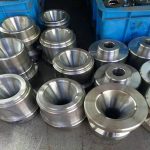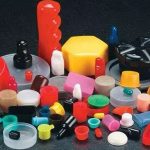What is the difference between forging and rolling?
| Rolling is a pressure processing method in which the metal blank passes through the gap (various shapes) of a pair of rotating rolls, and the material cross section is reduced by the compression of the rolls, and the length is increased. This is the most common production method for producing steel, and is mainly used for the production of steel. Production of profiles, plates, pipes. |

The rolling method is divided into rolling parts: vertical rolling, horizontal rolling, and cross rolling.
Longitudinal rolling: The process is a process in which metal passes between two rolls of opposite directions of rotation and plastically deforms therebetween.
Horizontal rolling: The direction of motion of the rolled piece after deformation is consistent with the direction of the roll axis.
Cross-rolling: The rolling piece is spirally moved, and the rolling piece and the roll axis are not angled.
advantage
The cast structure of the ingot can be destroyed, the grain of the steel can be refined, and the defects of the microstructure can be eliminated, so that the steel structure is compacted and the mechanical properties are improved. This improvement is mainly reflected in the rolling direction, so that the steel is no longer isotropic to a certain extent; bubbles, cracks and looseness formed during casting can also be welded under high temperature and pressure.
Disadvantage
- 1. After rolling, non-metallic inclusions (mainly sulfides and oxides, as well as silicates) inside the steel are pressed into thin sheets, and delamination (sandwich) occurs. The delamination greatly deteriorates the tensile properties of the steel in the thickness direction, and it is possible that interlaminar tearing occurs when the weld is shrunk. The local strain induced by weld shrinkage often reaches several times the yield point strain and is much larger than the strain caused by the load.
- 2. Residual stress caused by uneven cooling. The residual stress is the internal self-phase equilibrium stress without external force. The hot-rolled steel of various sections has such residual stress. The larger the section size of the general steel, the larger the residual stress. Although the residual stress is self-phase-balanced, it still has some influence on the performance of steel members under external force. Such as deformation, stability, fatigue and other aspects may have adverse effects.
- 3. Hot rolled steel products are not well controlled for thickness and side width. We are familiar with thermal expansion and contraction. Since the hot rolling is started at the beginning even if the length and thickness are up to standard, there will be a certain negative difference after cooling. The wider the width of the negative difference, the thicker the thickness is. Therefore, for large steel, the side width, thickness, length, angle, and edge of the steel cannot be too precise.
forging:
It is one of the two major components of forging (forging and stamping) by using a forging machine to apply pressure to a metal blank to plastically deform it to obtain a forging having a certain mechanical property, a certain shape and size. Through forging can eliminate defects such as as-cast looseness caused by metal in the smelting process, optimize the microstructure, and at the same time, the mechanical properties of the forgings are generally better than those of the same materials due to the preservation of the complete metal flow lines. For important parts of the relevant machinery with high load and severe working conditions, forgings are often used except for the available rolled sheets, profiles or welded parts.
Forging can be divided into free forging, die forging, closed die forging
- 1. Free forging. The impact force or pressure is used to deform the metal between the upper and lower two irons (anvil) to obtain the required forgings, mainly hand forging and mechanical forging.
- 2. die forging. Die forging is divided into open die forging and closed die forging. Metal blanks are pressed and deformed in a forged die with a certain shape to obtain forgings, which can be divided into cold heading, roll forging, radial forging and extrusion. Wait.
- 3. closed die forging and closed upset forging because there is no flash, the material utilization rate is high. Finishing of complex forgings is possible with one or several processes. Since there is no flash, the area of force applied to the forging is reduced and the required load is also reduced. However, care should be taken not to completely limit the blank. To this end, the volume of the blank is strictly controlled, the relative position of the forging die is controlled, and the forging is measured to reduce the wear of the forging die.
Features:
Compared with castings, forging metals can improve their microstructure and mechanical properties after forging. After the hot-working deformation of the cast structure by the forging method, the original coarse dendrites and columnar grains become the equiaxed recrystallized structure with fine grains and uniform size due to the deformation and recrystallization of the metal, so that the original segregation in the steel ingot, The compaction and welding of loose, stomata and slag inclusions make the structure more compact and improve the plasticity and mechanical properties of the metal.
The mechanical properties of castings are lower than those of forgings of the same material. In addition, the forging process can ensure the continuity of the metal fiber structure, so that the fiber structure of the forging piece is consistent with the shape of the forging piece, and the metal streamline is complete, which can ensure the good mechanical properties and long service life of the part by precision die forging and cold extrusion. Forgings produced by processes such as warm extrusion are incomparable to castings.
Comparison of forgings and rolling stock
- (1) The difference between the axial and radial mechanical properties of the forgings is smaller than that of the rolled parts. That is to say, the isotropy of the forgings is much higher than the isotropy of the rolled parts, so the life of the forgings is much higher than that of the rolled parts. Rolled parts. The figure below shows the metallographic diagram of the morphology of eutectic carbides in different directions of Cr12MoV rolled sheet.
- (2) From the degree of deformation, the degree of deformation of the forging is much greater than the degree of deformation of the rolled piece, that is, the effect of breaking the eutectic carbide by forging is better than the crushing effect of the rolling.
- (3) In terms of processing cost, the cost of forging is much higher than the cost of rolling. For some key parts, workpieces subjected to large loads or impacts, workpieces with complex shapes or very strict requirements, it is necessary to use forged Process for processing.
- (4) The forging has a complete metal streamline. After rolling, the mechanics destroy the integrity of the metal streamline, which greatly shortens the life of the workpiece. The figure below shows the metal flow lines for casting, machining, and forging workpieces.
Link to this article: The difference between forging and rolling
Reprint Statement: If there are no special instructions, all articles on this site are original. Please indicate the source for reprinting:https://www.cncmachiningptj.com/,thanks!
 PTJ® provides a full range of Custom Precision cnc machining china services.ISO 9001:2015 &AS-9100 certified. 3, 4 and 5-axis rapid precision CNC machining services including milling, turning to customer specifications,Capable of metal & plastic machined parts with +/-0.005 mm tolerance.Secondary services include CNC and conventional grinding, drilling,die casting,sheet metal and stamping.Providing prototypes, full production runs, technical support and full inspection.Serves the automotive, aerospace, mold&fixture,led lighting,medical,bicycle, and consumer electronics industries. On-time delivery.Tell us a little about your project’s budget and expected delivery time. We will strategize with you to provide the most cost-effective services to help you reach your target,Welcome to Contact us ( [email protected] ) directly for your new project.
PTJ® provides a full range of Custom Precision cnc machining china services.ISO 9001:2015 &AS-9100 certified. 3, 4 and 5-axis rapid precision CNC machining services including milling, turning to customer specifications,Capable of metal & plastic machined parts with +/-0.005 mm tolerance.Secondary services include CNC and conventional grinding, drilling,die casting,sheet metal and stamping.Providing prototypes, full production runs, technical support and full inspection.Serves the automotive, aerospace, mold&fixture,led lighting,medical,bicycle, and consumer electronics industries. On-time delivery.Tell us a little about your project’s budget and expected delivery time. We will strategize with you to provide the most cost-effective services to help you reach your target,Welcome to Contact us ( [email protected] ) directly for your new project.
Link to this article:The difference between forging and rolling
Reprint Statement: If there are no special instructions, all articles on this site are original. Please indicate the source for reprinting:Tungusten,Thanks!^^








